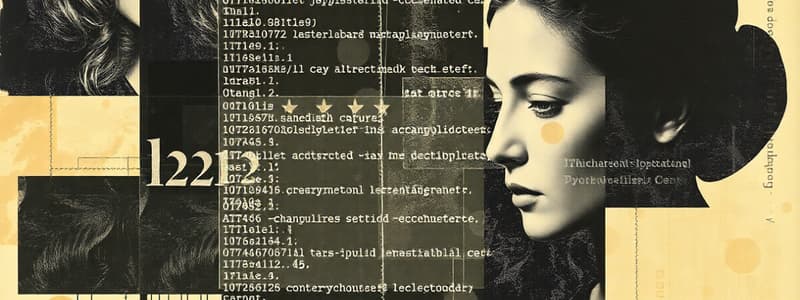Podcast
Questions and Answers
Which of the following accurately describes a flowchart's selection structure?
Which of the following accurately describes a flowchart's selection structure?
- It performs actions in a simple linear manner without decision points.
- It represents the beginning and ending of the flowchart with symbols.
- It allows for repetitive execution of an operation based on a condition.
- It navigates through operations based on conditions being true or false. (correct)
What is the primary role of a compiler in programming?
What is the primary role of a compiler in programming?
- To interpret the machine language back into a human-readable form.
- To provide a visual representation of the algorithm through flowcharts.
- To translate source code language to low-level language that the computer can understand. (correct)
- To execute the high-level language instructions directly on the machine.
What best defines the term 'binary' in the context of low-level language?
What best defines the term 'binary' in the context of low-level language?
- It refers to a representation of characters in text format.
- It consists of sequences of letters that form program instructions.
- It signifies a high-level programming language that requires compilation.
- It denotes the use of 1's and 0's as the fundamental language of computers. (correct)
What is an identifier in C++ programming?
What is an identifier in C++ programming?
Which statement correctly describes pseudocode?
Which statement correctly describes pseudocode?
What distinguishes a high-level language from a low-level language?
What distinguishes a high-level language from a low-level language?
In the context of flowcharts, what is the primary purpose of the sequence structure?
In the context of flowcharts, what is the primary purpose of the sequence structure?
Which statement correctly describes the role of a programmer?
Which statement correctly describes the role of a programmer?
What defines the role of a compiler in programming?
What defines the role of a compiler in programming?
Which of the following accurately represents the function of the insertion operator?
Which of the following accurately represents the function of the insertion operator?
In a binary system, which statement is true regarding its structure?
In a binary system, which statement is true regarding its structure?
What is the significance of mnemonic code in programming?
What is the significance of mnemonic code in programming?
What best describes the function of an input stream in computer operations?
What best describes the function of an input stream in computer operations?
Which statement characterizes the purpose of flowchart symbols?
Which statement characterizes the purpose of flowchart symbols?
What does the repetition structure in a flowchart ensure?
What does the repetition structure in a flowchart ensure?
Flashcards are hidden until you start studying
Study Notes
Algorithms and Pseudocode
- An algorithm is a structured set of instructions that solves a problem in a finite number of steps.
- Pseudocode is a way of writing algorithms using English statements.
Computer Basics
- Electricity is essential for a computer to operate.
- A program is a collection of instructions that tell a computer what to do.
- A programmer is someone who creates programs.
Programming Languages
- Machine Language is a low-level language using only 1s and 0s.
- Binary code is another name for machine language.
- Mnemonic code uses alphabetic abbreviations for program instructions, making it easier to understand than machine language.
- High-Level Language uses English-like instructions, requiring either an interpreter or a compiler to translate them into machine language.
- A compiler translates high-level code into machine language.
Input/Output and Flowcharts
- An input stream is a sequence of characters sent to the computer from an input device.
- The insertion operator (->) is used to indicate input.
- A flowchart is a visual representation of an algorithm, showing the sequence of steps involved in solving a problem.
- Flowchart symbols represent different operations and flow control.
- The START/STOP symbol marks the beginning and end of a flowchart.
Flowchart Structures
- Sequence Structure: Instructions are executed in a linear order, from one symbol to the next.
- Selection Structure: The flowchart branches based on the result of a condition (true or false).
- Repetition Structure (Loops): A block of instructions repeats while a certain condition is met.
C++ Variables
- In C++, variables must have unique names called identifiers to distinguish them.
Algorithms
- An algorithm is a structured set of steps used to solve a problem within a finite number of steps.
- Pseudocode is an algorithm written in English statements.
Computer Fundamentals
- Electricity is crucial for computer operation.
- A program is a collection of instructions guiding a computer's actions.
- A programmer creates programs.
- Machine language is a low-level language using only 1s and 0s.
- This binary system is also known as machine level language or low-level language.
- Mnemonic code is a method of abbreviation using alphabetic characters.
Programming Languages
- A compiler translates high-level source code into a low-level language understood by computers.
- High-level languages, like C++, require either an interpreter or a compiler to convert instructions.
Input and Output
- An input stream is a sequence of characters received by a computer from an input device.
- The insertion operator (->) is used in programming to move data from a source to a destination.
Flowcharts
- A flowchart visually displays the detailed sequence of operations in an algorithm.
- It includes geometrical symbols connected to depict the algorithm's steps.
- The "Start" and "Stop" symbols represent the beginning and end of the flowchart.
- Sequence Structure: Flowcharts progress linearly from one symbol to another.
- Selection Structure (Conditionals): The flowchart branches based on a true/false condition, determining the next action.
- Repetition Structure Iteration (Loops): Flowcharts repeat operations based on a condition being true.
Variables
- All C++ variables require unique identifiers or names.
Studying That Suits You
Use AI to generate personalized quizzes and flashcards to suit your learning preferences.




